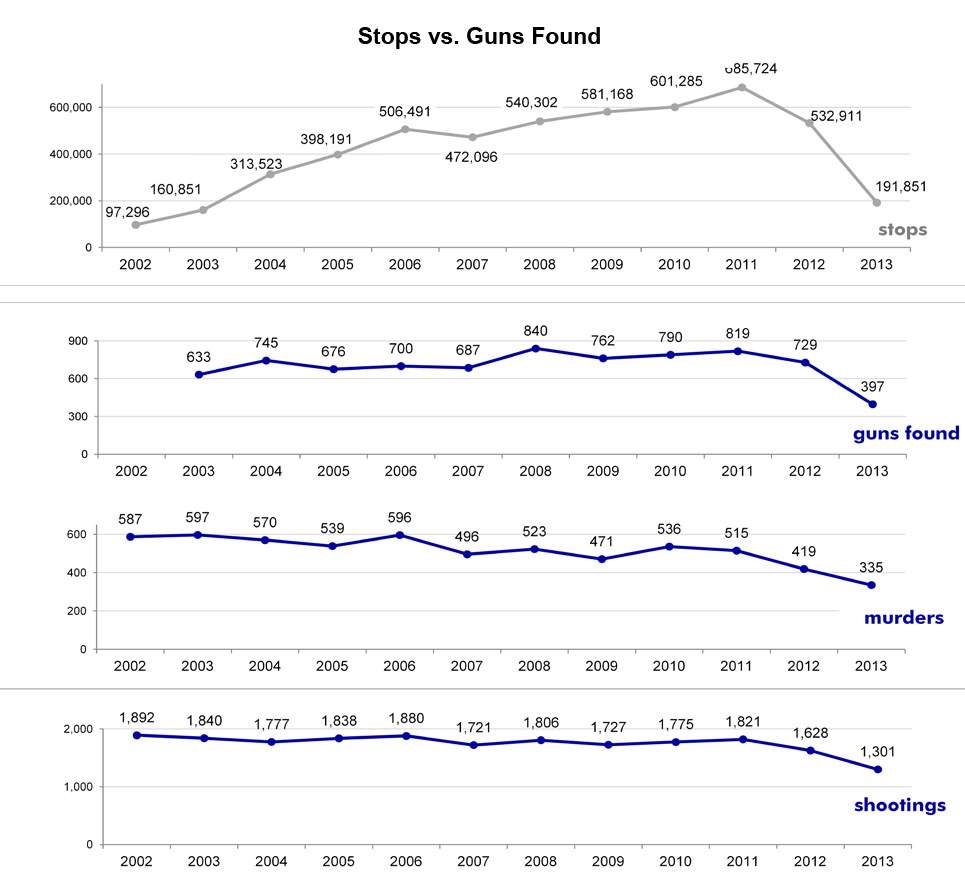Bloomberg's Stop-and-Frisk Explosion Looks Ineffective As Well As Unconstitutional
A new report from the New York Civil Liberties Union (NYCLU) suggests that the massive increase in street stops by the NYPD during Michael Bloomberg's administration had little, if any, impact on violent crime. The number of stop-and-frisk encounters septupled between 2002 and 2011, when it peaked at nearly 700,000, then fell sharply to less than 200,000 in 2013. Meanwhile, the number of murders, which peaked at 597 in 2003, bobbed up and down, then fell sharply after 2011, reaching a low of 335 last year. The number of shootings followed a similar pattern. In both cases the biggest declines coincided with the dramatic reduction in street stops during the last two years under Bloomberg.

The NYCLU's analysis of street stops during the 11 years for which detailed information is available (2003 through 2013) confirms patterns that are by now familiar: The vast majority of the people stopped by police (86 percent) were black or Latino, the vast majority of the stops (88 percent) ended without an arrest or a summons, and most (52 percent) included pat-downs, only 2 percent of which discovered weapons. These numbers are striking because the Supreme Court has said police may stop someone only if they reasonably suspect he is involved in criminal activity and may pat him down only if they reasonably suspect he is armed. Yet police wrongly suspected criminal activity nine times out 10 and were almost never right when they supposedly suspected someone was carrying a weapon. Given this record, it is not surprising that a federal judge concluded the NYPD was routinely violating New Yorkers' Fourth Amendment rights.
In defending the stop-and-frisk program, Bloomberg did not argue that it was constitutional. Instead he argued that it was effective. Specifically, he maintained that stopping and searching lots of young black and Latino men more or less at random discouraged them from carrying guns. The beauty of that argument was that it allowed Bloomberg to turn what looked like failure into success. Although getting guns off the street was one of the program's main justifications, only 0.02 percent of stops resulted in gun seizures. Bloomberg cited the remarkably low gun recovery rate as evidence that the stops were having the intended deterrent effect. But if so, and if that effect resulted in fewer shootings and murders, it is hard to explain why the downward trend in violent crime not only continued but accelerated when the number of stops dropped dramatically.
Editor's Note: As of February 29, 2024, commenting privileges on reason.com posts are limited to Reason Plus subscribers. Past commenters are grandfathered in for a temporary period. Subscribe here to preserve your ability to comment. Your Reason Plus subscription also gives you an ad-free version of reason.com, along with full access to the digital edition and archives of Reason magazine. We request that comments be civil and on-topic. We do not moderate or assume any responsibility for comments, which are owned by the readers who post them. Comments do not represent the views of reason.com or Reason Foundation. We reserve the right to delete any comment and ban commenters for any reason at any time. Comments may only be edited within 5 minutes of posting. Report abuses.
Please to post comments


Circular Logic is the very best kind of Logic.
Actually its super effective. A lot fewer minorities where I grew up in Manhattan than there were when I was a kid and a miniscule amount compared to the old days when my parents first moved there.
Still glad I moved to Houston though.
How many people who live in New York are actually from New York now a days?
Maybe the whole drop in crime thing stems from the fact that New Yorkers have few children and the violent traditionally violent criminal population has been supplanted by Midwestern and California hipsters.
I think the increase in the number of recent immigrants way outstrips any increase in hipsters, and probably plays some part in the reduction in crime.
Makes one wonder - maybe the point of the program was to find and confiscate firearms and other weapons and not actually do anything about crime? Nah - not Nanny Bloomberg...
2% or .02%, Sullum? The difference is only two orders of magnitude...
Math is hard!
Why use one chart when 4 will do less effectively!
*(this was more of a college-paper rule, tho probably not as applicable to jornalisms)
Time ofrr a good ole fashion smack down.
http://www.AnonCrypt.tk
If the Brown vs. Board of Education decision that "separate but equal" was unconstitutional was based not on its intent but its effect, does the mirror logic apply? That is, if it's *not* effective (per the graphs shown, or better, one showing no or minimal change in # of shootings as a function of # of stops), then can it be argued that the intent (reducing # of shootings) doesn't matter and that the policy is unconstitutional? Or, more simply put, since there is no effect, doesn't the injunction "first, do no harm" should apply? (The harm being to liberty, aka the fourth Amendment.)